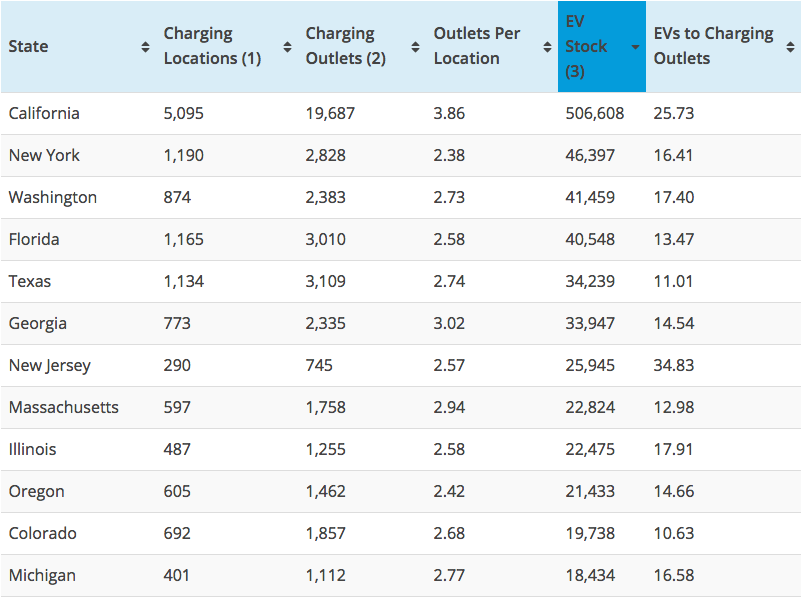How many public EV charging stations are needed within a market to support the charging needs of owners of EVs within a market?
This equilibrium can be measured and expressed in somewhat simple terms through the ratio of total EV stock to available public charging connections.
For example, we’ve recently updated the Charging Stations by State table on EVAdoption that shows the current ratio for each state (and the District of Columbia) in the US. The ratio varies widely from a high (worst) of 34.83 in New Jersey to a low (best) in Wyoming of 1.89.
Several of the states with the lowest ratio of EVs to charging connections are in fact states with a very low level of cumulative EV stock. Meaning that in many low adoption regions, the supply of EV charging stations actually outpaces demand.
Conversely, California with the highest stock of EVs and highest market share in the US that reached 10% in the last few months of 2018, has the second highest (worst) ratio at 25.73, after New Jersey (34.83) and Oklahoma (29.10). The median ratio is 11.15 across the 50 states and District of Columbia.
Looking at the top 12 states in the US with the most EVs sold since 2011 (chart below), the ratio ranges from a low (best) of 10.63 to 1 in Colorado to a high of 34.83 in New Jersey.

In its calculations of the number of charging stations needed in the future, the International Energy Association (IEA) has recommended on a European level a ratio of 10 EVs to 1 charging connection. Compare that, however, to Norway today, the country with the highest EV share at nearly 50% of new vehicles sold, that has by my estimate a ratio of 31 EVs to 1 charging station. This is in a similar range to that of California at 25.7 to 1.
A study by the European Commission’s Joint Research Centre (JRC) shows that early EV adopters are less reliant on the provision of public charging infrastructure. They indicated availability of public charging becomes more important only after the share of EVs in the vehicle fleet exceeds 5%, a level only likely to be reached around 2025 in leading markets.
Source: ICCT – Quantifying the electric vehicle charging infrastructure gap across U.S. markets
One of the reasons the need for more charging stations per EV increases along with adoption, is that a much higher percentage of early adopting EV buyers live in single-family (detached) homes where the homeowner controls charging access. The chart below is a perfect example, showing in California that homeowners of detached homes purchase EVs at a rate of 13 percentage points higher than general new vehicle buys.
Over time as more renters adopt EVs, the need for more public charging stations increases, especially as owners of many multi-family unit developments are reticent to invest in installing charging stations until there is a clear and strong demand and when a lack of access to charging for tenants becomes a competitive disadvantage.
So what will be the necessary ratio of EVs to charging connections in the future to ensure “equilibrium” and adequate supply that would minimize lines of EVs waiting to charge, like you might see during gasoline/petrol shortages?
Based on current real-world situations in high adoption markets like Norway and California, I believe the the IEA’s target ratio of 10 to 1 is perhaps a bit too aggressive. Obviously the more charging stations the better, but today the fundamental question is not What is the ideal rate?, but What is the minimum acceptable ratio that gives comfort to mainstream car buyers that are considering the purchase of an EV?
The minimum acceptable ratio is actually going to vary a fair amount by the unique combination of factors in each region and market, which is the focus of a follow-on article. With that said, however, my belief is that at least for the next 5-7 years, a ratio of 15-20 to 1 will in fact meet demand in most markets.
In part 2, 8 Factors That Will Affect the Number, Type and Location of Charging Stations Needed to Support Electric Vehicles, I explore the various factors – including battery range, autonomous vehicles, ride sharing, charging speed, BEV/PHEV mix, home ownership, and more – that will affect the necessary ratio of EVs to charging stations in a regional market.
Related Resources:
 Announcing the acquisition of EVAdoption by Paren →
Announcing the acquisition of EVAdoption by Paren →
3 Responses
My main issue with statistics like this and raw station counts from the AFDC is that they do nothing to help the average consumer who is holding back buying an EV because of range anxiety. I’ve started an exploration of the subject on my blog at https://greatplainsev.blogspot.com/2020/04/measuring-ev-infrastructure-part-1.html
Oops – I goofed up the link – sorry.
https://greatplainsev.blogspot.com/2020/03/measuring-ev-infrastructure-pt1.html